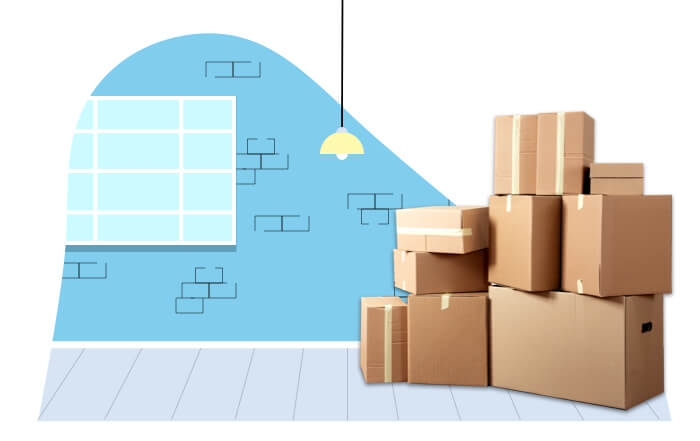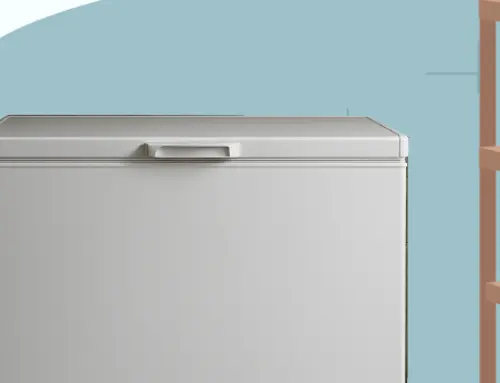Moving Checklist: Top Things You Need To Do & When
by Jenna Mendez
14.9 min read

The Ultimate Moving Checklist & Timeline
You’ve just closed on your new home or apartment! Moving to a new house or apartment is exciting, especially with children, and there’s more to consider beyond just how you’re going to pack everything — you’ll need to update records, set up a new utility account, submit a change of address, and more. This is especially true if you’re moving to a new city or new state, where there may be additional considerations you now have to account for. Don’t sweat it, because we’re here to help with our guide for making your big move a snap.
Read on to see how we break down your big move into a time frame of activities to help keep everything manageable and on-time. We’ve also included a downloadable version of our guide so you can easily check off each step. It should be a big help to get everything (and everyone) organized.
Now, let’s get started with your earliest preparations, starting at about two months before your move.
Two months before moving
It might be tough to plan out your moving schedule, but that’s why we’re starting early! We recommend that around eight weeks before your moving date is a great time to start getting organized. The earlier you start, the easier the process will be. And if you have less than two full months for your move, prioritize these steps and determine which ones need to get done.
- Give any required notices. If you have a landlord and a lease, then you’re likely required to give notice that you’re moving out — especially if it’s before the contractual end of a lease. You’re usually required to give at least 60 days’ notice, but double check your lease agreement for specific details, especially about possible early termination. Your landlord may be willing to work with you depending on the circumstances. Be aware that breaking a lease could result in a fine, a lower credit score, or even a lawsuit if you refuse to pay any associated fines or fees. Depending on your work situation, you may also need to schedule time off. If you’re keeping your job during your move, be sure to reserve those dates as soon as possible to avoid any scheduling conflicts.
- Set your moving budget. You’re going to need supplies and equipment. Determine how much you’re comfortable spending on the move and where you may be able to save some money. For example, instead of buying new boxes and containers, are you able to source free ones from friends and family? Are you comfortable asking local businesses — such as liquor stores, bookstores, grocery stores, and retailers — if you can take any used boxes? If you’re relocating for work, ask your employer if they can cover some of the expenses. With some careful planning, you’ll ensure that your move is both on-time and under budget.
- Research moving companies. The more you know the better, especially if you need to hire a moving company. At the very least, you’re going to need to rent a moving truck, so don’t wait to reserve what you need. Start researching moving companies to compare services and pricing. It’s important to protect yourself and your belongings from shady businesses, so it’s important to ensure that the moving company is either licensed or registered (depending on the state). Try to get the moving estimate in writing and ensure that it has a U.S. Department of Transportation (USDOT) number on it, which confirms that the company is registered with the U.S. Department of Transportation.
- Know your surroundings. While you probably already have a good idea of where you’re moving to, consider doing some additional research on your new location. Visit your moving site ahead of time to get familiar with the layout of your new neighborhood and the surrounding areas. You’ll want to research if there are any moving requirements or restrictions — such as noise ordinances or truck weight limits on certain roads. You can check maps to find the most efficient routes to major highways, to help make your move easier. Finally, identify any important location that you may need to visit within the first week, such as grocery stores, pharmacies, hospitals and government buildings.
- Start taking stock of your belongings. Before you actually start packing, go through each room and decide which of your belongings are definitely coming with you and which are going to be sold, donated, or disposed of. Take careful consideration of any items that may need special packing or insurance coverage — not only is that part of your budget planning, it’s important for protecting your most cherished and valued belongings.
- Start organizing your records. Ensure that you’ve collected and organized all of your existing paper records — taxes, medical history, licenses, personal information, etc. — and start keeping track of your moving estimates, expenses, and inventory. If you have children, you’ll need to find a new school for them to attend. Once you’ve found their new school and have them enrolled, be sure to make arrangements to have their school records transferred to their new school district.
Six weeks before moving
- Gather your moving supplies. Whether you’re collecting used items or purchasing new ones, you’ll need to start getting your supplies together. Keep your boxes, tape, markers, bubble wrap, and any specialty containers in a specific location. That way everyone knows where to access them and you’ll be able to keep track of when you need to order more.
- Determine what’s going to fit in your new home and what’s going to storage. Nothing’s worse than finding out you’re not going to be able to fit a piece of furniture into your new house on moving day. It’s helpful to have measurements taken of all entryways and stairways in your new home. That way you can ensure that every piece of furniture is going to fit, or determine if you’re going to have to make some adjustments. Also, are you able to move everything into your new house in one day? Or are some things just not the right fit for your new place? If some things may need to wait in storage, you have a couple options. Try to reserve a storage unit near your new address to keep things secure for the time being. If you don’t have access to a storage unit, reach out to friends and family to see if they’re willing to hold on to them for you.
- Update insurance information. Contact your home and auto insurance agents to update your information. You’ll have to cancel your previous homeowners policy and start a new policy for your new house. You should also ask if your policy covers your possessions during the move — do you have full-value coverage for any lost or damaged items or released-value coverage that only covers part of the cost? If you need help, call your insurance agent or contact a customer representative through their website. If you’re moving to a new state (or country) then ask your agent or representative if your coverage will apply at your new location and if there are any new limitations or requirements. If your existing insurance company doesn’t write policies for your new location, then consider working with an independent broker or do your own research to find new coverage. Actually, even if your existing insurance does provide coverage, try researching competitors anyways to see if you can get similar (or better) coverage at lower rates.
- Start using up your perishable goods. Make things easier for yourself and plan to use up any food or cleaning supplies that you don’t want to take with you. Consider keeping a small box of cleaning supplies handy — for use during the move if needed — and some food and drinks for the road. Use up any canned or dry goods as well; you can replace your perishables over time once you settle in at the new place.
- Start reaching out to friends and family. Everyone needs some help now and then, and it’s not too early to call in some favors and ask family and friends to assist with packing and organizing. Even if they don’t help with the actual move, any assistance they can offer is one less thing you have to worry about.
One month before moving
- Select your moving company. It’s time to finalize your moving plans and hire the services you’ll need. Ensure that they’ll do a thorough walk through of your home to take inventory of your belongings and accurately measure the bulk and weight of your move. Ask about any additional fees that may apply for a move and get everything in writing. When you enter into a contract with a moving company, be sure to get written confirmation of the date and costs, as well as the details of any moving insurance you’ve purchased. If you’re asked to pay some of the cost in advance, use a credit card to better protect yourself from fraud.
- Start packing and labeling. Now it’s time to actually start the physical work of moving. Go room by room, separating out what you’re packing from what you’re leaving behind. Have an organized system for what gets packed (ex. all books are packed together, all utensils and plates are together, etc.) and label all your boxes appropriately. Take special care of valuables and fragile materials, packing them away in extra wrapping or specialized containers.
As for the things you’re not taking, consider donating them to appropriate charities and thrift stores. If you’re up for it, consider hosting a garage or yard sale to make a few extra dollars in the process. - Submit a change of address. Contact your local post office or go directly to the USPS site. There’s always a chance that some mail may get delivered to your old address, so if you know who’s moving into your old house, ask them to forward any of your mail. If your old place is going to remain empty for the immediate future, you can reach out to a neighbor to check for you.If you’re moving in-state, then visit the local bureau or division of motor vehicles office to update your license to reflect your new address. If you’re moving to a new state then you’ll need a new license from that state, usually within 10-60 days of moving. You’ll also need to start updating your address with online services and e-commerce platforms like Amazon.
- Inform important parties about your move. While common job courtesy is to provide at least two weeks’ notice, consider informing your employer about your move about a month in advance. It will help with the transition period at work and ensure that you leave on good terms. You’ll also want to inform your bank, credit card companies, and other financial institutions or lenders. If you have any local memberships or subscriptions, determine if you’ll still be able to use them or if you should cancel them.
- Make pet plans. If you have a cat or dog, it’s important to keep them as comfortable and stress-free as possible during the move. Stick to the established feeding and play routines to keep their stress levels low and provide them a rest area away from the packing activity. Be sure to check in with your veterinarian to ensure your pets are up-to-date on all their vaccines, and also ask for advice on finding a vet at your new location. Don’t forget to research the pet laws at your new address — as they might be different — and update your pet’s microchip information.
- Transfer utility services. You’ll need to contact your current electricity, gas, water, sewage, garbage, and internet providers to cancel services the day after you move. At the same time you’ll need to find providers at your new location and give them a month’s notice so they have time to set up service.Water, sewage, and garbage collection are likely managed by the town or city, so contact the public utilities office to set up start dates. If you’re moving to a deregulated area, then you may have a choice of retail gas or electricity providers. Research the different energy providers and choose the one with the energy plans and services that best fit your needs. If you’re a resident of Ohio, Illinois, Pennsylvania, Michigan, or Indiana, then Santanna Energy Services would be proud to be your energy service provider.
Check If You’re In Our Coverage Area
Whatever you choose, make sure your utilities will be turned on for the day you move into your new home.
One week before moving
- Check your prescriptions. If you or any member of your family are taking medications, make sure there’s enough to last through at least a few weeks of settling in at the new location. Refill and stock up before you move and find a new pharmacy that you can forward your prescriptions to.
- Make plant plans. Set aside the plants you’re planning on taking with you. Consider moving plants out of breakable clay pots to more durable plastic ones. Take care when packing them — you may need to carefully wrap leaves and branches to protect them from breaking. Water them normally, being careful not to overwater. As for the rest, try to find them new homes with friends, family, and neighbors.
- Finalize your address changes and any walkthroughs. Now’s the time to finalize and submit the last of your address changes to ensure that any mail or packages will be delivered to your new home. If you have a landlord at your old home, schedule a time for a final walkthrough and inspection. This will help find a convenient time to finalize any end-of-contract matters like a safety deposit return.
A few days before moving
- Start packing your suitcases. If your move is going to take more than a day, pack up the clothes and toiletries you’ll need for your trip. You may want to have some clothes and personal supplies handy for a few extra days, just in case it takes a while to unpack everything.
- Clean and prepare the refrigerator. If you’re taking your refrigerator with you, be sure to clean it thoroughly and then unplug it to defrost it at least 24 hours ahead of the actual move. If you’re leaving it behind, then take any perishables you want with you in the cooler. Otherwise, empty and clean it as a courtesy for the next occupants.
- Double check your utilities. Make sure that your current utility companies have the correct last date for service. You don’t want to be paying for anything that you’re not using. Also, reach out to your new utility company to double check that services will be available on the day of your move.
- Back up your home computer. Whether you have a laptop or desktop, it’s a good idea to back up your important files on a cloud service or on a portable hard drive. If you’re using physical storage, carefully pack it and keep it in a separate box from your computer.
- Confirm details with your movers if you have them. Call them up and double-check all the important details, including arrival time, directions, and methods of payment. You can also tell them where to park ahead of time. Talk to your children about the movers and make plans for how you’ll secure your pets.
- Withdraw some cash to have on hand. Credit cards, debit cards, and digital wallets are likely good enough to get you where you’re going, but it’s generally a good idea to have some cash handy while on the road. It’s also good to have some cash on hand to tip your movers.
Moving day
- Verify the moving truck. If you’re not picking up the moving truck yourself, then you’ll want to ensure that any truck that arrives is with the company you hired. Cross reference the USDOT number on the truck with your moving contract to ensure that you’re getting what you paid for.
- Take a full inventory. As boxes and furniture are moved out, take stock of everything to make sure nothing gets left behind. Keep a checklist handy to mark off items as they’re loaded in the moving truck.
- Pack tightly and secure everything. Not only do you want to maximize your space, but using all the available space will help ensure that things don’t move around too much during the trip. Take the time to tie things down to prevent excess movement.
Once everything is packed up and you’ve done a last walkthrough of your old place, it’s time to hit the road. Take a look at Google maps or other digital map application to review your predetermined route and see if there’s any delays or major traffic. If it’s a long trip, try to plan out for rest stops and where you’d like to eat. Once you arrive at your destination you can be confident that you’ve accounted for all the important elements and can start moving into your new home.
Moving soon and want to keep this checklist handy? Download our free Moving Out Checklist.
Moving to an area that’s serviced by Santanna Energy? You can choose from different energy plans tailored to your lifestyle. Review our available plans and select the one that best suits your energy needs.
Jenna Mendez is a Midwest native with lifelong roots in Illinois and time spent in Ohio during college, giving her a deep understanding of the Midwest region’s people, climate, and energy needs. She brings firsthand experience and local insight to topics that matter to Midwest homeowners, especially energy efficiency, sustainability, and home living. Jenna specializes in writing about eco-friendly living, all things Midwest, renewable energy, and practical ways to reduce energy costs. Jenna brings a trusted, and local hometown voice to every article she writes, helping readers live well, and sustainably, right where they are.







